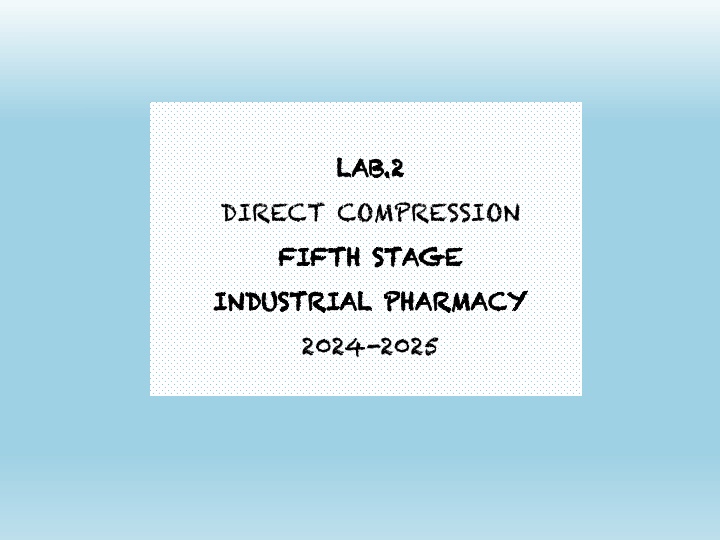
Direct Compression in Tablet Manufacturing: Methods and Excipients
Learn about the direct compression method in tablet manufacturing, its advantages, challenges, and ideal excipients. Explore the process, comparison with other methods, and factors influencing successful tablet production.
Download Presentation

Please find below an Image/Link to download the presentation.
The content on the website is provided AS IS for your information and personal use only. It may not be sold, licensed, or shared on other websites without obtaining consent from the author. If you encounter any issues during the download, it is possible that the publisher has removed the file from their server.
You are allowed to download the files provided on this website for personal or commercial use, subject to the condition that they are used lawfully. All files are the property of their respective owners.
The content on the website is provided AS IS for your information and personal use only. It may not be sold, licensed, or shared on other websites without obtaining consent from the author.
E N D
Presentation Transcript
LAB. LAB.2 2 DIRECT COMPRESSION FIFTH STAGE FIFTH STAGE INDUSTRIAL PHARMACY INDUSTRIAL PHARMACY 2024-2025
TABLET PRODUCTION METHODS There Are Three Methods Of Tablet Manufacture Designed To Confer These Essential Attributes To A Tablet Formulation. Wet Granulation And Direct Compression Are The Most Important, With Dry Granulation Used In Some Circumstances Regardless Whether Tablets Are Made By Direct Compression Or Granulation, The First Step Which Is, Milling And Mixing, Is The Same; Subsequent Step Differ.
DIRECT COMPRESSION direct compression is the easiest and most cost-effective process for tablet manufacturing, because it only involves blending and compression. consists of compressing the substances together with any substance of physical property enable to compress directly with good flowability. a crystalline structure, is more easily to compress than amorphous form because of the creation of certain cohesive bonds between crystals due to the pressure of compression, whereas in amorphous form it will not. addition of a disintegrant to the formulation will aid to avoid the major problems in disintegration like (long time dissolution and melting). Disintegration of conventional compressed tablet must occur within 15 minutes.
Simplely it includes blending the API and excipients followed by compression 4
not all materials can be easily or directly compressed: 1. most materials having weak intermolecular attracting forces. 2. large doses drugs do not lend themselves to this technique due to: need of additives in a ratio of 1:1 for e.g. active constituent 500mg and diluent 500mg so will form (large tab., costly, difficult to swallow and not accepted by patients). 3. small doses drugs can t be compressed directly like digoxin because there may be not sure to distribute uniformly. NOTE: Materials with improper functionalities could lead to serious problems , such as sticking; content non-uniformity and capping
IDEAL DIRECT COMPRESSION EXCIPIENTS: It is important to note that many excipients can possess multi-functionality, which is dependent upon the concentration at which they are employed. For example, microcrystalline cellulose can be used as an anti-adherent (5 20%), a disintegrant (5 15%) and as a diluent (20 90%). Flowability Stable, inert, compatible Compressibility Particle size should be of high range, to meet the particle size of the drug (be close to it) Otherwise segregation (demixing) will occur leading to lack of content uniformity Low cost Provide high pressure-hardness profile.
ADVANTAGES OF DIRECT COMPRESSION: Requires fewer unit operations compared with wet granulation (shorter processing time and lower energy consumption) fewer stability issues for actives that are sensitive to heat or moisture For certain compounds, faster dissolution rates may be generated from tablets prepared by direct compression compared with wet granulation; for example, norfloxacin fewer excipients may be needed in a direct compression formula
DISADVANTAGES OF DIRECT COMPRESSION Issues with segregation these can be reduced by matching the particle size and density of the active drug substance with excipients Reactions of excipients with the drug like reaction of spray dry lactose with amine resulting in yellowish discoloration while the original color is brown (incompatibility). In general, the drug content is limited to approximately 30% or approximately 50 mg. May not be applicable for materials possessing a low bulk density because after compression the tablets produced may be too thin. Not suited for poorly flowing drug compounds. Static charges may develop on the drug particles or excipients during mixing, which may lead to agglomeration of particles producing poor mixing.
EXPERIMENT PART AIM OF EXPERIMENT : PREPARATION OF ASPIRIN TABLETS BY DIRECT COMPRESSION Preformulation test: 1. Organoleptic properties a) (crystalline tubular or needle shape) b) Bitter or slightly acidic taste c) Odorless or have odor due to formation of acetic acid and S.A. in the presence of moisture.
2. Solubility Slightly soluble in water (1:300), highly soluble in organic solvent (1:5-7 alcohol, 2:10-17 ether, 1:17 chloroform). Partition coefficient High (high solubility in lipids) and thus having good absorption in GIT wall so it is highly absorbed from stomach but also having good absorption from small intestine due to large surface area. 3. Stability (unstable in water) due to decomposition (hydrolysis) so it dissolves in aq. Solution of carbonate and alkali hydroxyl with decomposition
FORMULA Aspirin 75mg (api) Starch 10mg (disintegrant) Lactose 40mg (diluent) Mg stearate 2mg (lubricant) 1. Mix all ingredients together after weighing (aspirin, disintegrant , diluent) for 15 minutes 2. Then add the lubricant and mix for not more than 5 minutes 3. Directly compress lubricant is added at last step . Why?






















